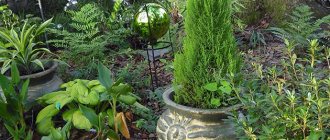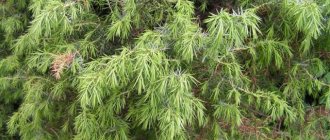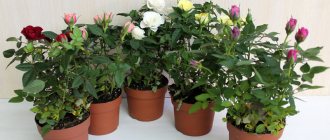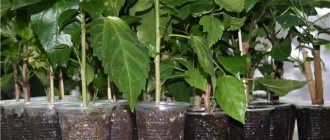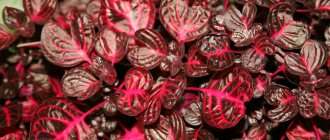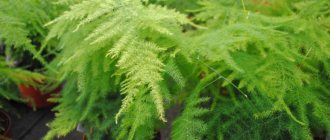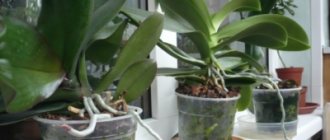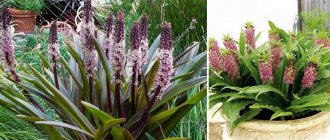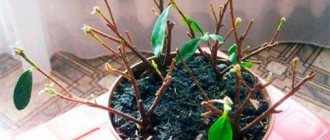Diseases and pests of indoor cypress: why does it dry out? What to do for other problems?
Domestic cypress is an evergreen plant that is very similar to wild cypress, although smaller in size.
It is very popular among gardeners and is actively grown in apartments and offices.
In a pot, this plant looks like a miniature tree with a regular pyramidal crown. And its needles release beneficial phytoncides and smell pleasant.
But not everything is as simple in growing it as we would like. In this article we will talk in detail about what diseases and pests threaten it and what needs to be done to avoid them.
This pretty tree is demanding of environmental conditions, and at the slightest deviation from them it begins to hurt. One of the most common problems is when the cypress has dried out , what to do in this case, what kind of care does it need to provide?
Diseases
Many gardeners note that domestic cypress trees are prone to yellowing and drying out, and their needles fall off.
This is his reaction to uncomfortable conditions, the impact of unfavorable environmental factors. The thing is that cypress is capricious and for proper maintenance you will have to work hard and create favorable conditions for the plant. All types of cypress need to create certain comfortable conditions. Evergreen, Siberian cypress and Goldcrest Wilma are most often grown indoors.
Why does indoor cypress dry out ? If your home cypress dries out, you must first determine whether it is being cared for correctly.
Cypress needs:
- Good lighting.
This plant loves light very much, and therefore should be exposed to bright light for at least 10 hours a day. During the period when the daylight hours are shorter (from late autumn to early spring), you need to take care of additional lighting. However, exposure to direct sunlight should not be allowed - the tree must be shaded. Temperature .
Cypress does not like high temperatures; the most comfortable temperature for it is +18-20 degrees. When the temperature in the room is above +27 degrees, its needles begin to actively dry out and fall off - in this situation, the pot must be quickly moved to the shade and doused with water at least 2-3 times a day. In addition, the plant does not tolerate being in a draft . Watering .
The plant very often begins to dry out due to infrequent watering. But overwatering is also dangerous for it - due to increased humidity, root rot can begin, after which the cypress is usually sent to a bucket. Watering must be done when the top layer of soil has dried out, while making sure that excess water passes well through the holes of the pot.
For watering, you need to use melted or well-settled water - the plant reacts negatively to the presence of chlorine and heavy metals. Fertilizer application .
Cypress does not like the lack of minerals in the soil. It is best to feed it with liquid fertilizer for coniferous plants, or granules, which dissolve within 2 weeks, providing a constant source of nutrients. There is no need to fertilize if the plant has recently been transplanted into new soil. Regular transplantation .
With strong root growth, the crown begins to dry out. This happens because the roots occupy the entire space of the pot and have a hard time drawing in nutrients. To prevent this from happening, it is advisable to replant the cypress every 2 years into a larger pot.
How to replant a cypress:
The procedure is carried out as follows. The cypress is taken by the base of the trunk, the pot is turned over and the earthen lump is pulled out of it. After this, the root system is carefully cleared of old soil.
A thick layer of drainage filler is poured into the bottom of the new pot to prevent stagnation of water, and then soil is placed. After filling the voids between the roots, the soil can be compacted a little.
By the way, cypress can be propagated independently using seeds. Read a detailed article about this on our website.
What to do if the cypress dries out?
Why does cypress dry out? Let's look at conifer diseases and treatment methods. We offer a proven technique for restoring cypress.
What to do if the cypress dries out?
It is more convenient to assess the condition of the cypress at home - it is easy to determine which branches are healthy and which have begun to dry out. Coniferous trees are generally resistant to changes in microclimate or changes in weather conditions that affect development, but are susceptible to diseases and pests.
Briefly about the needs of cypress at home:
- air temperature +21° C. In winter up to +5° C.
- diffused lighting, shaded area.
- rocky, loose soil.
- choosing a deep pot.
- regular pruning (from the 5th year).
In the spring, the cypress is renewed by checking the branches and inspecting the woody part for the presence of pests. With regular pruning, the crown is perfectly renewed. Cypress turns yellow if the room is dark - lighting is necessary for development, movement, and renewal of branches. Often the lighting problem manifests itself in the spring.
Lack of moisture in the room and overdried substrate also disrupt the functioning of cypress. The plant needs watering and spraying during hot periods. However, given the changeable weather conditions at the beginning of spring, there is no need to flood or use direct spraying of cypress.
Lack of nutrients in the soil, depletion of the soil and, as a consequence, roots, lead to the death of the surface part. It is necessary to apply fertilizers annually and, if possible, update the soil mixture by removing the top layer of soil.
What to feed:
- Liquid organics.
- Liquid complex fertilizers.
- Mixtures for coniferous plants.
We identify problems with cypress - why does it dry out?
If you notice that the tips of the cypress branches are brown and dry, this is a lack of watering.
If the appearance of yellow spots added to the dryness, use hard water, which washed out the calcium. The dual impact requires an integrated approach to treatment.
Problems with the upper shoots - yellowing, drying out - indicate exposure to a draft or dry air. Indoor cypress - care at home.
Inspect the lower shoots - if you find a clutch of parasites, treat with a 0.15% Actellica solution. Repeat the procedure until you remove the pests. In order to avoid addiction, you can spray it with Karbofos.
Spider mites are a separate issue if the cypress dries out. The pest appears on an overdried plant if there is dry air in the room, or elevated temperature combined with exposure to direct rays. Start by restoring home indicators, then treat with Aktara, introduce air humidification and spray the plant. Moderate moisture will help to gradually get rid of the parasite. To consolidate the result, spray with Karbofos.
What to feed for recovery:
How to quickly heal, covering all branches:
Treat with insecticide and cover with cellophane.
Prevention after recovery:
- Transplantation into fresh substrate. Replanting cypress at home.
- Composition of soil for cypress: 1 part turf, 2 parts leaf, 1 part steamed river sand + drainage layer on the bottom.
Please rate the material you read :)
Pests
Home cypress is susceptible to infection by common flower pests - scale insects, aphids, and spider mites.
In order to reduce the chances of their occurrence, it is necessary to follow the rules of care and perform regular inspections. Main pests of indoor cypress :
- The spider mite weaves a thin white web around the shoots. If it is detected, the plant must be washed with soapy water and treated with insecticides.
- Scale insects look like raised brown spots on the branches and trunk. It sticks to the plant and consumes its sap, which is why the cypress can dry out and fall off. To combat this pest, you need to wash the plant with a soap solution; if this does not help, then spray any chemical pest control agent.
- Aphids are small, whitish insects that primarily live on the undersides of leaves. It is destroyed only with specialized preparations, and spraying must be repeated after a while.
Diseases and pests of cypress, what to do if the cypress dries out
Cypress is an excellent “forest substitute” that can be grown both in a room and on a plot.
The aroma that comes from this small tree is reminiscent of walks in the fresh air in coniferous forests. Cypress is an evergreen plant, a representative of the cypress genus. It has two crowns: spreading and pyramidal. Nowadays, the species has 14-25 varieties. An adult tree can reach 25 meters in natural conditions, and in a home or indoor tree, of course, it is smaller in size. Today we will talk about what to do if the cypress dries out, and how to prevent this.
In your case, you can try to revive the cypress.
Free the plant from the pot and, shaking off the soil, carefully examine the roots of the cypress. If they are still alive, plant the cypress in a new soil substrate (mixture for conifers) with a mandatory drainage layer and a hole for water drainage. After replanting the plant, cover its crown with a transparent plastic bag, thereby building a mini-greenhouse. Ventilate the plant daily, preventing condensation from accumulating on the bag, and spray the crown with water with the addition of a biostimulator until young growth appears. Also, do not forget to maintain high air humidity for the cypress - twice a day, spraying the crown and placing the pot with the plant in a pan of water. But be sure to place it on a stand so that water from the pan does not flow into the drainage hole, but, by evaporating, maintains the desired level of humidity. In the spring, with the onset of stable positive temperatures, do not forget to take the cypress tree out into the open air.
Ask experienced flower growers, and they will tell you that during the USSR, no one even heard of the fact that coniferous trees could be grown on window sills.
Today this will not surprise anyone, because dwarf conifers take root well in the conditions of our apartments. Now many enthusiasts grow thuja, cryptomeria, cypress and even cedar trees in pots.
This list also contains an interesting plant, which we will talk about today - Hamaecypress
or
cypress
(chamaecyparis).
Cypress is a miniature indoor coniferous tree. It is also called false cypress
,
chamecypress
or
indoor cypress
.
This handsome coniferous tree can not only decorate a home, but also benefit the health of its owners by releasing substances into the atmosphere that can kill pathogenic bacteria and microorganisms. Of course, to grow a handsome conifer, you will need a lot of attention and care. However, the beauty and benefits of chamecyparis are undoubtedly worth the effort.
How nice it is to hear the fresh forest aroma
!
Basic mistakes in caring for cypress
Cypress trees dry out most often due to improper care. The Mediterranean is considered to be the birthplace of cypress. Therefore, in order for cypress to feel comfortable in your home, you need to provide it with a warm, humid place.
Lighting and temperature
In order for the cypress to feel comfortable in the room and its branches not to dry out, it is better to place it so that the lighting is bright but diffused.
Watering and fertilizing the plant
Cypress needs to be watered correctly, maintain sufficient air humidity and properly fertilize the plant. Due to the fact that in its homeland cypress grows in damp places and often near bodies of water, at home it also needs to be provided with good moisture. If the cypress tree begins to dry out, it does not have enough water. Therefore, the plant is sprayed with warm water or periodically “bathed”.
It needs to be watered as it matures:
the older and more perfect the root system, the more water it requires, so when the top layer of the substrate dries out, the cypress is watered. If it’s summer outside, we water more, in winter – less.
The main thing is not to overwater, because a humid environment is an excellent place for the development of fungal diseases. If you notice that your cypress is falling off and you don’t understand what you did wrong, you should think about whether you are fertilizing your plant correctly. For fertilizer, it is better to use fertilizers based on mineral substances, and not those that contain a large amount of nitrogen (it can dry out the roots). When spraying in summer, do not use liquid fertilizers.
Trimming errors
Pruning cypress is necessary to rejuvenate plants and prevent diseases, as well as simply to give them a new, more decorative look. A mistake when pruning is to cut off too many branches in the first year, which will not have time to recover. You need to prune gradually, removing all yellowed branches and old shoots, since they do not allow light to pass through. It is necessary to use only sharp pruning shears and do this with quick and sharp movements.
Cypress diseases, all about treating plant ailments
As we already know, cypress is grown as an indoor plant and as an outdoor plant. Most often, cypress diseases appear as a result of improper care.
Fusarium
Fusarium is also known as tracheomycosis - a disease that begins with rotting of the roots and then affects the entire plant.
Very often, the disease is already present in seedlings, seeds, or can be stored in the soil. The best prevention of this disease is timely ventilation and loosening of the soil; you should also disinfect all material and tools that you use when working with plants.
Most often, a diseased plant cannot be cured; in this case, it is simply uprooted and disposed of.
If it is less than 60% affected, you can try to save it by rooting the cuttings. For a cutting, the top shoot is usually selected, treated with Fundazol, and left for eight hours in its solution with a small amount of Epin. If the cutting has taken root, the disease has passed. By the way, “Fundazol” is also excellent for preventing fusarium.
Brown Schutte
Brown schutte is a typical disease for conifers. Most often it appears on young plants immediately after the snow melts, when the plant is still very weak. External signs are darkening of the plant and a coating similar to a cobweb. This disease loves shade and waterlogging. For treatment, you need to use lime-sulfur preparations - “Abiga-Peak” or Bordeaux mixture. Spraying should be carried out in the spring and must be repeated in the summer.
Fungal diseases
Fungal diseases can lead to withering and drying out of branches and damage to the bark. In order to avoid fungal diseases, it is necessary to promptly remove dead shoots, loosen the soil and remove fallen leaves (if we are talking about street cypress) from under the plant, because most fungi live in such places. After you remove the diseased plant, you need to treat the soil and nearby plants with Abiga-Peak or Bordeaux mixture.
Cypress diseases
Diseases of cypress: fusarium, brown schutte, fungal drying and wilting of branches, root rot.
Fusarium
This disease is also known as tracheomycosis. With this disease, the roots first rot, and then over time the entire plant suffers. It is not difficult to notice signs of the disease, because... the shoots of the tree become yellow, and the bark on the stem acquires a pronounced brownish tint. Most often, the disease appears along with planting material or is already embedded in the ground.
Brown Schutte
This disease most often affects coniferous plants. Often, signs of the disease become noticeable in early spring, when the snow melts and the plant has not yet grown stronger after wintering. Symptoms of the disease are the appearance of a cobwebby coating and an uncharacteristic dark color of the plant. Favorable conditions for the development of the disease are constant shade and high air and soil humidity.
Read also: How to propagate common heather, we study methods
To cure cypress from this disease, you need to use sulfur-lime preparations, for example, “Abiga-Peak” or Bordeaux mixture. It is recommended to process in spring and summer.
Fungal drying and wilting of branches
Because of the fungus, branches can dry out and wither, and the bark can also be damaged. To prevent fungal diseases from affecting the cypress tree, you need to promptly trim off bad damaged shoots, weed the soil and clear the area of fallen leaves, because Most often there is fungus there. It is advisable to remove the diseased plant and disinfect the soil and neighboring crops with Abiga-Peak or Bordeaux mixture.
Root rot
This is a fungal disease that appears due to waterlogging of the roots when it begins to stagnate in them. For preventative purposes, be sure to place broken bricks and sand in the hole when planting. If signs of the disease are not detected in time and treatment is not started, the plant will die.
A diseased cypress tree needs to be dug up and its roots cut back to a healthy base, and then treated with fungicides. Next, the plant needs to be replanted, observing all the rules for this work. If the disease destroys the rhizome, the cypress tree should be disposed of.
Late blight
When infected with late blight, the shoots begin to wither, and eventually the entire cypress tree. It becomes grayish in color, dries, and then turns brown. The rhizome rots and also turns brown. When the disease first strikes, its signs are difficult to notice, because there are no signs of decay on the roots.
In case of severe damage, the cypress tree must be removed from the area and destroyed. For the purpose of prevention and at the first minor symptoms, the soil must be treated with a special preparation, for example, “Alyet” or “Ridomil Gold”. When planting, be sure to drain the soil.
Branch burn
Often shoots from the fungus become yellow and later brown. Plants located in a shaded or damp place are especially susceptible. The same symptoms also appear in non-parasitic disorders, for example due to magnesium deficiency. In case of illness, you need to remove the damaged parts of the cypress tree and thin out the surrounding plants so that the cypress tree dries out faster.
Pests of outdoor and indoor cypress
In order for your plants to be protected from pests, you need to know what kind of parasites can live on your plant.
The main pests of indoor cypress
Cypress needs to be constantly “inspected” for the appearance of pests and damage by them. Most often these are aphids, scale insects and spider mites.
You will notice the presence of spider mites on your plant if white cobwebs appear on the branches.
Insecticides are used to combat it. For example, “Vermitek”, “Aktofit”, “Fitoverm”.
You may have to reuse these medications. Folk remedies such as soap solution will be effective in the fight. The scale insect sucks the juices out of the plant, and the tree dries out. Brown spots on the trunk are the first sign of scale insects. The fight against this insect consists of treating with soapy water and any of the insecticides. You can collect insects by hand, but be sure to do this with gloves.
Aphids are white insects that live on the inside of leaves.
It can only be destroyed with special preparations, the treatment of which will have to be repeated.
Outdoor cypress pests
Juniper scale insects and seaside mealybugs are very common. If you notice caterpillars on your bush, this is a sign of damage to the bush by gypsy moth butterflies and juniper cutworm. These insects damage buds and cones. Insects can also damage the trunk and bark - this is done by pine beetles and bark beetles. If you notice pine beetles on your cypress tree, then the branch damaged by this insect must be cut down and the cut treated with oil paint. In order to destroy bark beetles at an early stage, you should inject the bark with the drug “Aktelik”.
In May-June, plants are treated with preparations such as “Fufanon” and “Profi”. In order for your cypress to exude health and evoke only positive emotions in you, it is necessary to properly care for it and protect it from all kinds of pests and diseases.
Diseases of indoor cypress
Here we have a beautiful cypress tree. We look after him, give a certain part of our soul. But at one point, it begins to dry, turn yellow, and crumble. This may be due to errors in care, disease or insects. To prevent a disease or cure our plant, we need to find out the cause and eliminate it. We will talk about this further.
Insects. Only a few types of insects pose a threat to our home cypress. But they can cause significant harm through their livelihoods.
The first to be presented to your attention are scale insects, as well as false scale insects. They belong to the coccid family, but they have different families. The females of these insects are larger in size and they “sit in one place.” Males are smaller than females and are mobile.
The whole danger of scale insects is that they feed on plant sap, slowly and reliably killing it. Also, females attach to one place on the leaf and remain there to protect their larvae. By doing this, they cause damage to the leaves, which manifests itself as yellow or brick-colored spots.
They look like small yellowish, greenish plaques on the foliage that may contain a sticky secretion. If at least one scale insect is noticed, immediately take the necessary measures to eliminate them. To do this you need:
- Wet the cypress with soapy water using a soft brush or cotton swab. This eliminates adult insects.
- Treat the tree with an insecticide. The pot, shelf or window sill where your cypress was located, and window glass are also processed. You can use Actellik solution as an insecticide.
On a note
. Atellik is an insecticide-acaricide. It is based on organophosphorus substances, the main one of which is pirimiphos-methyl. Designed to combat almost all types of vegetation pests. Known for its high speed and duration of action, as well as a fairly wide spectrum of action.
Important! The drug is toxic, so take precautions. Keep out of the reach of children.
We would like to bring to your attention another harmful pest of vegetation – the spider mite. It has a yellow-green, milky-transparent color, its dimensions vary up to 1 mm, sometimes up to 2 mm. Typical habitat is the underside of leaves.
The first signs of pest activity from these insects are light spots. Further, they actively crawl all over the needles. As a result, they create cobweb-like clusters everywhere. Although ticks are afraid of moisture, simply spraying with water or soapy water does not help. You need to resort to the help of actellik, alcohol and special sticks - Plant-Pin and Etisso.
Indoor cypress dries
Lemon or indoor cypress in Latin is called Cypress large-fruited (Cupressus macrocarpa).
It can be successfully grown indoors, as its presence adds a fresh lemon scent every time you rub it against the growth of coniferous branches. But many gardeners complain that indoor cypress needles begin to turn yellow and the tops dry out. Why does this happen, and how to save the plant? Why does indoor cypress dry out?
To grow successfully indoors, indoor cypress requires special care, so to preserve your plant for a long time, follow the recommendations below.
Step 1 - Lighting
Place the indoor cypress tree in a brightly lit window, but with
shading from direct sunlight. The plant needs 10 hours of lighting, and if this is not possible, then install additional light in the form of a special lamp for indoor flowers. Step 2 - Temperature
Indoor cypress prefers lower temperatures, and in the hot climate of the room its needles begin to dry out, especially if the room is closed and poorly ventilated. In summer, it is better to allocate a place for this conifer on the street or balcony, so it will receive more light and fresh air.
Due to lack of moisture, cypress needles may also begin to dry out and turn yellow. But this plant should only be watered when the top layer of soil feels dry to the touch. Overwatering is very harmful to the root system of indoor cypress. When watering, make sure the water drains away
through the drainage holes and does not stagnate at the bottom. Root rot, the result of overwatering, is a very dangerous disease, because once you destroy the roots, you are unlikely to bring the cypress tree back to life. In winter, watering should be done a little less often. Several times throughout the year, you can spray the needles with a very weak solution of soapy water (using tar soap) to prevent spider mites and other indoor pests, and then rinse the plant with clean water. To water your home cypress, it is better to use melt water, but if this is not available, you can leave tap water for 24 hours. You cannot water the plant with tap water, because lime, metals and other compounds in such water negatively affect the condition of the plant, which can cause the needles of your home cypress to begin to dry out.
Step 4 - Fertilizers
Indoor cypress dries out due to lack of nutrients in the soil. Fertilize your coniferous plant 2 times a month with liquid
conifer fertilizer or granules with a slow-release formula. That is, the nutrients will gradually dissolve in the soil, and the plant will be able to be provided with all the necessary substances for growth for 14 days before the next feeding. If you have just transplanted an indoor cypress into fresh soil, then the plant will feed directly on substances from the soil and you do not need to feed it for a long period of time.
Pruning not only adds aesthetic appeal to your green pet, but also stimulates the growth of new shoots. Since cypress grows very quickly, it should be pruned once a week during the summer. Indoor cypress can be formed into interesting shapes, such as a spiral, ball, cube and others. The main thing is to choose the figure that you like and will suit the interior of your home and garden. Although for lovers of the classics, you can let the cypress grow naturally, without
pruning, but in this case the growth of side shoots will be slow and the plant will stretch upward.
Causes of yellowing. What do we have to do
This species has special qualities. For example, cold resistance. Wintering in an apartment is difficult for cypress. But sudden hypothermia can also have a detrimental effect on the plant. For example, you bought and transported a seedling in cold weather. The temperature difference is obvious.
Important! Be careful when pruning - remove only old branches. Removing a large number of shoots in the first year is disastrous.
If the cypress you are growing begins to turn yellow and dry out, then the watering or temperature conditions were probably disturbed. Lack of lighting and fertilizer also affects the plant. Conifers suffer from various diseases, they are affected by insect pests. It is important to understand the reasons, understand what steps should be taken when needles turn yellow, and what preventive measures to take against cypress diseases.
A bush growing at home in a pot and its root system may not have enough space.
First you should inspect the bush. Bare the roots from the ground and check if they are alive. If all is well, you should replant the plant. Select a substrate special for conifers. Drain. Having a tray with water will be very appropriate. It is useful to cover the transplanted tree with film or polyethylene, but do not allow condensation to accumulate. Ventilate the soil by opening the film. And most importantly, irrigate with a spray bottle a couple of times a day. The causes of drying out and methods of protection are listed below step by step.
We recommend learning how to distinguish thuja from cypress.
Improper watering
Cypress trees love moisture, because in nature they grow near bodies of water in humid air. It is important to water the plants, spray them, sprinkle them - it all depends on where exactly your bush grows. A moderate supply of moisture will revive the conifer. By the way, this genus of plants prefers warm and settled water. It is important to ensure that the top layer of soil does not dry out. When it began to dry, then it was time to irrigate.
As the cypress ages, it needs to be watered more and more, because the root system also grows. Thanks to the drainage system, water penetrates well into the soil, flows down and does not stagnate at the bottom. From the tray in which the pot with the plant stands, the cypress itself can take the required amount of water with its roots. Summer watering occurs more often than winter watering.
Important! Avoid overwatering. This can cause fungal diseases.
Lack of fertilizer
It is useful to feed cypress. Due to the absence or lack of nutrients, the plant also dries out. It is recommended to use special fertilizers for coniferous species based on nitrogen, phosphorus and potassium. Use these products twice a month. The transplanted plant should not be fed, but if the soil has been chosen suitable. The bush will take all the nutrition it needs from fresh soil.
There are also special nutritional granules (Agrecol, Royal Mix). They gradually release beneficial substances over a certain period of time. If you start using this type of fertilizer, then the cypress will be provided with the necessary nutrition for two weeks.
Lack of space in the pot
If you notice that the top and side shoots have turned yellow, then the reason for the poor appearance of the cypress most likely lies in the lack of space in the pot for the roots. In this case, the plant should be urgently replanted. To do this, you need to take the bush by the base and turn over the container in which it grows. Carefully release the roots. Remove the earth from them, that is, the part that crumbles easily.
Did you know? Cypress is the hero of ancient Greek legend.
It symbolizes endless sorrow. Now the transplantation should be performed. The pot this time should be significantly larger. Sprinkle a few centimeters of soil at the bottom of the new container. Next, lower the roots of the bush and cover them with soil. It is worth compacting the soil slightly and watering it. Replanting at home with good growth can be done every two years.
By the way, to easily remove a plant from a pot, place it in a bucket of water - the soil will get wet and the root system will be easy to remove.
Incorrect temperature and lighting
A coniferous houseplant of this genus does not like direct sunlight, but it requires good lighting. The required light time is approximately ten hours. It is difficult to maintain such a regime constantly. Therefore, you can purchase special lamps. Infrared and phytolamps should be used as much as there is not enough natural light. High air temperature, dryness and lack of ventilation negatively affect coniferous plants.
The bush needs a temperature below room temperature, and in the summer it is good for it to be outdoors. Place your indoor plant on the balcony. Here it will receive the right amount of light. Natural conditions are suitable for growing cypress trees. A garden plant needs enough natural light; it responds well to lower temperatures. The shrub grows well in partial shade.
Diseases
Not only violation of agricultural practices harms cypress. He has his own illnesses.
Among these:
- fusarium;
- brown shutte;
- various fungi.
Find out also how to grow cypress from seeds.
With fusarium, the roots are affected and they begin to rot. Then the disease affects the entire bush: the shoots turn yellow, the bark turns brown. You can save a diseased cypress if it is less than half affected. Use propagation by cuttings. Select the top healthy shoot of the diseased plant, cut it off with pruning shears, and treat it with foundationazole (within 8 hours). Place it in water to let it take root. A healthy branch should cope.
Video: red needles on a cypress
If the plant has darkened and acquired a coating (in the form of a cobweb), it means that it is affected by Schutte. Street cypress trees usually get sick due to growing in the shade and high humidity.
Processing time and name of funds are presented in the list:
- Late autumn, spring after the snow melts. "Kurzat" (0.7%) or copper oxychloride (0.5%).
- During spring (March – April). Frequency: every 10 days. "Fundazol" (0.2%).
- In the spring before the growing season. "Terminator" and "Zircon". Content per 10 liters of water: 0.05% of the first and 0.01% of the second.
Fungal diseases cause branches to wither and become dry, and the bark to become damaged. Loosening and pruning old shoots is the prevention of such diseases. If your cypress grows in the garden, you should promptly remove fallen leaves from under the bush. It is better to remove the diseased plant. The remaining bushes must be treated with a solution of copper sulfate (1%). Use this way: dilute 100 g of the drug in 10 liters of water (+50°C). Spray.
Did you know? The ancient Egyptians made sarcophagi from cypress because it contains a lot of resin, which ensures the preservation of the wood.
Pests
Scale insects, spider mites, and various aphids are classic cypress pests.
Symptoms in a house plant:
- white cobwebs on shoots;
- the appearance of brown spots on the trunk;
- white insects visible to the eye.
You should use insecticides for plants in the house (“Aktofit”, “Fitoverm” or others, see the instructions on the packaging of each drug). They also use a soap solution (dilute 1 part soap in 6 parts water), and wash the bush with it to get rid of insects.
Scale insects can be collected by hand, after wearing gloves. It is important to re-treat with the same pest control agents. Tobacco dust is also used against aphids. There are various ways to use it. Try this: pour half a glass of dust purchased at a garden store with 1 liter of water, cook for an hour, not forgetting to add the evaporated liquid.
Next, leave the broth to infuse for a day. Strain and add another 2 liters of water. Spray the bush with the resulting product 2 or 3 times every week. Caterpillars may appear on outdoor cypress trees. These are pests such as silkworms or cutworms (butterflies). Caterpillars infect buds and cones. The bark is eaten by pine beetles and bark beetles. The plant weakens and turns yellow. The best thing to do is destroy it.
Removal of affected areas and injections into the bark (use Artelik) help against insects. The plant is treated with the drug "Fufanon" (see manufacturer's instructions on the package) or similar ones from May to early summer (June).
We recommend reading about cypress propagation by cuttings.
What kind of cypress can be grown indoors?
Large-fruited cypress, grown in a pot on a windowsill, differs from its counterparts from subtropical groves only in size. In its homeland, in California, the tree reaches a height of 25 m, and in indoor conditions its maximum height is 2 m. The home cypress has the shape of an elongated cone, shoots densely covered with small leaves-scales and fruits - ovoid cones.
Attention! Very often, indoor cypress is confused with cypress. You can distinguish them by the color of the needles - the first one is dark green, the second one is light green.
It has been proven that growing cypress indoors has a positive effect on the human respiratory system. This is due to the release of phytoncides into the indoor air - volatile substances that have a detrimental effect on microorganisms, including pathogenic ones.
16 excellent varieties of plums for the Moscow region
Home cypress - description
Decorative cypress, that is, cypress grown in a pot, differs from a tree or bush growing in nature, for example, in our Crimea, only in smaller size. The same shape, the same soft shoots, covered on all sides with scale-like leaves shaped like an elongated diamond. The color of the leaves is dark green with a bluish tint. The fruit is an ovoid cone with shield-shaped scales, under which cypress seeds are hidden. Sometimes the home cypress (Cupressus) is confused with the similar cypress tree (Chamaecyparis), which has light green needles, but this does not harm either plant, since caring for the home cypress and the similar cypress tree is approximately the same. It is worth warning, however, those who want to grow cypress in their home that it is capricious and demanding.
Caring for indoor cypress
If you care for the cypress properly, it will delight you with its beautiful appearance for many years. The main thing is to create conditions for it that are close to those in which it grows in nature.
Lighting. Cypress is a native of the southern regions, so it prefers good lighting. However, direct sunlight can cause significant damage to the tree. Under natural conditions, only mature, strong plants can withstand the sun. So the best windows for indoor pets are those that face east or northeast.
Room temperature . In order for large-fruited cypress to grow and develop well, it needs warmth in the summer months and coolness in the winter months. In summer, home cypress requires a temperature of + 20°C and above. The plant feels very good in the yard or on the balcony.
In winter, the temperature in the room with the growing tree should not exceed +15°C. The best conditions for it this season are +8..+10°C. Such a place can be found on an insulated apartment balcony or an unheated extension of a private house. If you leave a cypress tree to winter on a windowsill with a heating radiator located under it, the tree will die.
Advice. To prevent cypress roots from freezing in a cold room in winter, you can insulate the flowerpot by wrapping it in several layers of thick fabric or covering it with foam plastic.
Watering . From spring to autumn, cypress needs to be well watered. The higher the room temperature, the more often you need to do this. The soil in the flowerpot should not be allowed to dry out, but excess moisture is also unnecessary. Therefore, when planting, you need to ensure good drainage.
In winter, cypress needs to be watered every 7-10 days. In the summer, even if the plant is placed outside, it must be periodically sprayed to maintain the required humidity.
Flower bed design. TOP 10 simple and effective techniques
Fertilizing the soil. Indoor cypress should be fed with liquid mineral fertilizer regularly once every month and a half. During the period when it is actively growing, that is, in the spring, you should fertilize the soil once a month.
Transplant a. Young plants require annual replanting in the spring, and older plants require replanting as needed. To avoid damaging the roots, the cypress needs to be transferred along with the soil into a larger pot.
Reproduction . Indoor cypress can be propagated by seeds and cuttings. In the first case, seeds can be purchased at the store. They need to be placed in the refrigerator for 3-4 months (stratified), and before sowing, soaked for 12 hours in warm water with the addition of growth stimulants.
Planting material is sown in boxes filled with wet sand or sawdust, and as soon as shoots appear, the plants are transplanted into a soil mixture for conifers. The germination rate of large-fruited cypress seeds is not high—less than half of them germinate.
An indoor tree can also be propagated from semi-lignified cuttings remaining after the crown has formed. To do this, the lower leaves are removed and the branches are immersed in a solution of a growth stimulator for a day. Then the cuttings are planted in a box with soil and a greenhouse made of glass or polyethylene is installed above them. Rooting occurs after at least two months.
Homemade cypress - the aroma of a coniferous forest in your home
Decorative cypress (domestic) is similar to a tree growing in nature, but is smaller in size. The crown shape of cypress trees can be diamond-shaped or pyramidal. The trunk of the tree is covered with grayish-brown bark.
The branches are quite dense, strewn with scale-shaped or diamond-shaped leaves. Leaf color ranges from dark green to greenish blue. Having ethereal glands on its leaves, indoor cypress has a specific odor.
Types of indoor cypress trees
If we consider candidates for coniferous ornamental indoor plants, then cypress is the best choice. The most common types:
- Goldcrest;
- Arizonan;
- Evergreen;
- Lusitanian;
- Knight's and Bentham's cypresses;
- Large-fruited;
- Kashmiri.
Let us dwell in more detail on each of the above-mentioned types.
- The peculiarity of the Goldcrest variety is the unusual color of its leaves. They are similar to fern fronds, but are golden yellow in color. Its slender trunk and unusual crown make it stand out from the rest.
- Arizona cypress has pale green-gray foliage. The bark tends to peel off in the form of narrow fibers. The advantages of this species are drought and frost resistance.
- Evergreen - refers to a low-demanding plant species. The pyramid-shaped crown has short branches that adhere tightly to the trunk. It can grow in any soil, but still gives preference to deep and fresh soils. This plant is resilient and tolerates pruning well.
- Lusitanian or Mexican - a plant with a brown-reddish trunk, distinguished by the presence of elongated shoots located in different planes. A fast-growing plant with a wide pyramidal crown. This breed is sensitive to cold and comes in a variety of decorative forms.
- Knight's cypress with shoots branching in one plane, has a certain structure of sprouts and the color of the needles is gray.
- The sad variety gets its name due to its columnar crown and downward-pointing branches. The blue needles are richly gray and have a coating that lasts for a long time on the cones. The shoots are slightly thicker than the usual form and do not tolerate dryness and temperature changes.
- Bentham is similar to the Knight form, differs in the color of the needles. May be bright green or blue-red. It has a crown of regular narrowed shape.
- Lindleya is a cypress with large cones and dark green shoots.
- Kashmiri cypress loves watering and warmth. Ideal for indoor conditions.
- The most common type for growing at home is the large-fruited variety. This is a beautiful tree with a pyramid-shaped crown and a slender, erect trunk. The crown of the tree is greenish-yellow, and the lower branches are quite dark. In winter, it should be placed on a window where there is more light. The desired air temperature should be about 25 C.
The cypress family is significantly different from other conifers. Cypress, cypress, thuja, juniper - they all grow very slowly, but live long - up to 300 years.
Beneficial properties of indoor cypress species
Cypress is valued for its usefulness and invaluable healing properties. The most valuable thing in these plants is cypress oil. The plant is especially popular in folk medicine. The oil has a beneficial effect on:
- menopause;
- bronchial asthma;
- bronchitis and whooping cough;
- combating stress;
- varicose veins (to eliminate swelling);
- bleeding gums;
- nosebleeds;
- excessive sweating.
In addition, it is widely used in the perfume industry and aromatherapy. Unique properties will improve eczema conditions and help cleanse the blood.
Caring for indoor cypress
A prerequisite for the comfortable stay of this slender handsome man in the house is proper care.
It is necessary to follow a number of rules: maintain the desired temperature, ensure proper watering, and take care of the health of the plant. The most common problem is that cypress needles dry out.
And in order to eliminate this problem, it is best to understand the question of what to do so that it does not dry out at all, step by step.
Let's start with temperature. For cypress, the most acceptable temperature will be from 18 to 20 degrees. When the heat is over 27 degrees, the plant dries out intensively, and then you need to do this: take the pot into the shade and provide dousing from a watering can at least 2-3 times in the heat of the moment.
The light should be bright, but direct sunlight should still be avoided. Diffused light is more suitable. In summer, the best gift for cypress will be fresh air. It is worth placing the flowerpot on an open terrace or balcony. But cypress must be protected from drafts.
The danger is that the leaves will turn yellow and begin to fall off. It is advisable to spray the flowerpot twice a day in the summer, morning and evening. It is better to use warm water.
This procedure will benefit the plant, and in gratitude you will receive a room filled with a pleasant aroma.
Upon the onset of autumn or spring, cypress trees require abundant watering, but the main thing is not to overdo it. Drying out the soil is just as undesirable as excess water.
In winter, special care is required. Hot air from radiators can dry out the air in the room, which will become a prerequisite for spider mites to attack the cypress tree. If such a problem does arise, then it must be dealt with immediately.
It is necessary to humidify the air around the tree and treat it with a special product - fitoverm. In winter, good lighting is also a prerequisite, and the temperature ranges from 8 to 15 degrees. Watering should be done once a week. Cypress requires mandatory feeding with fertilizers. It should be done once a month.
No pruning is required; the plant develops perfectly. Many owners of indoor conifers ask the question why sometimes cypress and cypress simply die in 1-2 days, despite normal care. Most often, the reason why this happens is waterlogging and stagnation of water in the flowerpot.
When, after purchasing, you replant a cypress or cypress tree, you must ensure high-quality drainage.
Reasons for drying out of large-fruited cypress
There may be several reasons for this change in appearance:
- very dry indoor air;
- water used for irrigation is of poor quality;
- the plant does not have enough lighting;
- the temperature regime is not observed;
- lack of nutrients in the soil.
In addition, leaf scales may turn yellow and crumble after careless transplantation.
Attention! The above reasons can not only spoil the attractive appearance of the plant, but also completely destroy it. Therefore, you need to immediately identify them and begin eliminating them.
Large-fruited cypress is a capricious plant that requires due attention. But, with proper care, it will purify the air and fill your home with the unique natural aroma of a coniferous forest.
Indoor cypress is drying out - what to do?
If your indoor cypress is drying out, then you need to find out as soon as possible why this is happening. After this it will be easier for you to save him.
Reasons for drying out of indoor cypress
Indoor cypress most often dries out due to improper care. It is especially sensitive to:
- air temperature and humidity level in the room where it is located;
- pot size;
- the presence of nutrients in the soil;
- watering regime;
- maintaining a rest regime during the winter months.
Whatever the reason, everything is quite simple to fix, the main thing is to start doing right what you did wrong, and the flower will come to life.
What to do if indoor cypress dries out?
Yellow cypress branches give a signal to the grower that he is feeling unwell, so it is necessary to change something as quickly as possible.
To provide the plant with the necessary amount of moisture, it should be watered after the top layer of soil has dried.
Overdoing it in this matter is also harmful; it can provoke the development of root rot, so the pot must have holes for draining water. In hot climates, in addition to regular watering, cypress trees should be sprayed daily.
Problems in growing indoor cypress
Sometimes growing ornamental green plants at home causes certain difficulties for gardeners. It is worth learning all the nuances of how to care for cypress in a pot at home.
Leaves turn yellow and fall off
Indoor cypress leaves begin to turn yellow and crumble from a banal excess of light. First of all, the plant needs to be protected from direct sunlight and shaded a little. The following may also be the cause of this problem:
- dry air;
- insufficient watering;
- deficiency of nutrients in the soil;
- excess calcium due to the use of hard water for irrigation.
Improper care causes yellowing and falling leaves
If measures are not taken in time, the green pet may dry out completely.
The tips of the leaves are drying out
If the tips of the cypress leaves begin to dry out, this indicates dry air in the room, insufficient watering or drafts. These symptoms are also observed if the branches touch cold glass in winter.
Cypress also suffers in the same way. Proper care will help preserve the decorative qualities of a green pet. Otherwise, it may simply dry out.
Pests
Of the pests, the cypress bush is most often affected by:
- aphids;
- spider mite;
- mealybug;
- scale insect;
- mining moth.
Pests pose a serious threat to the plant
Dry air, taking cypress outside, or using soil for planting that has not undergone preliminary disinfection can provoke the appearance of pests.
Attention! To control pests, plants are treated with an acaricide or insecticide that is approved for use at home.
Indoor decorative cypress is also susceptible to the negative effects of pests. When they appear, the bush begins to dry out and loses its decorative effect. Timely treatments and preventive measures can save it.
Diseases and pests of cypress, what to do if the cypress dries out
The Russian name of the breed, reminiscent of the southern cypress tree, obviously created some psychological barrier for it among landscapers and gardeners. Meanwhile, at the cypress tree
There are species that are quite winter-hardy. These types of cypress can be recommended for cultivation even in central Russia.
Cypress pea 'Bulevar'. Obtained in 1934 in Canada by Boulevar Nurseries during vegetative propagation of the 'Squarrosa' variety. Widely distributed in Europe. Like other forms of this species, it is hardy in the middle zone. A low-growing shrub with a wide-conical crown up to 2 m high and up to 1 m in diameter. Short, densely branched shoots grow horizontally. The annual growth is 10 cm in length and 5 cm in width. The needles are needle-shaped, thick, soft, silver-blue in summer, more ashy in winter. The root system is densely branched, superficial, with many thin adventitious roots. It can grow in both acidic and alkaline soils, but moist and fertile. Sensitive to soil compaction and poor aeration. The habitat is best sunny, but partial shade is also possible. Planted as individual specimens in rocky gardens, this type of cypress is suitable for containers.
Fig.1 Cypress pea “Bulevar”
Cypress pea 'Filifera Aurea'. A squat, round or cushion-shaped plant up to 1.5 m high, up to 3 m in diameter. The shoots are thread-like, densely branched, arched. The annual growth is about 5 cm in length and width. The needles are needle-shaped, adjacent, intense golden-yellow color all year round. The roots are thin, abundantly branched in the surface layer. Soils can be neutral to highly alkaline, moist and fertile. The location is sunny. This cypress tree is used alone in rocky and small gardens.
Cypress pea 'Filifera Nana'. In cultivation since 1891. Low-growing shrub, at a young age with a rounded or cushion-shaped crown, later - highly vaulted; height 2 m, crown diameter up to 3 m. Shoots are fan-shaped or thread-like, densely spaced, arcuate at the bottom.
